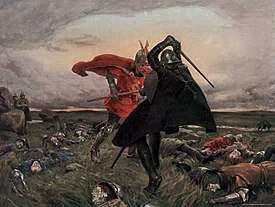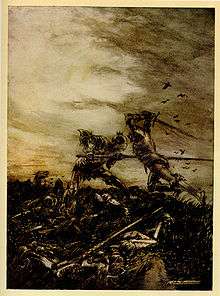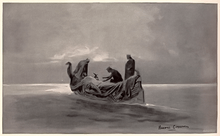Battle of Camlann
The Battle of Camlann (Welsh: Gwaith Camlan or Brwydr Camlan) is a legendary final battle of King Arthur during the early 6th century, in which he either died or was fatally wounded while fighting either with or against Mordred, who is also said to have died. Its medieval depictions are generally based on that of a catastrophic conflict described in the pseudo-chronicle Historia Regum Britanniae, and their variants from the later chivalric romance tradition include the telling in Le Morte d'Arthur that remains popular today.

Etymology
The name may derive from a Brittonic *Cambo-landa ("crooked/twisting-enclosure" or "crooked/twisting open land"),[1] or (less likely) *Cambo-glanna ("crooked/twisting bank (of a river)"), as found in the name of the Roman fort of Camboglanna (Castlesteads) in Cumbria.[2][3][4]
Historicity
The earliest reference to the Battle of Camlann is an entry in the mid 10th-century Annales Cambriae for the year 537:[lower-alpha 1] "The Battle of Camlann, in which Arthur and Medraut fell, and there was great mortality in Britain and Ireland." This is also the first mention of Medraut (later Mordred), but it does not specify whether he and Arthur fought on the same side or who won the battle.[6]
Andrew Breeze comments: "As for Camlann in the Welsh annals, R.G. Collingwood (1889-1943) regarded Crawford's 1935 proposal that Camlann was Camboglanna on Hadrian's Wall as convincing." Discussing further indications suggesting Camlann as Castlesteads, near Carlisle, Breeze concludes: "There is every reason to think that, in 537, when the walls of this stronghold stood high [...], Arthur was killed [there] by men of Rheged, the British kingdom centred on Penrith."[7] However, most historians regard Arthur and the Battle of Camlann as legendary.[8][9] Nick Higham argues that as Camlann is not mentioned in the list of Arthur's battles in the ninth-century Historia Brittonum, the Annales Cambriae's source was probably an Old Welsh elegy or lament about a different Arthur, perhaps one listed in the genealogy of the kings of Dyfed.[10]
Legendary versions
Medieval Welsh tradition
Camlann is mentioned in the circa 9th/10th-century Englynion y Beddau ("Stanzas of the Graves", Stanza 12) from the Black Book of Carmarthen as the site of the grave of Osfran's (unnamed) son.[11][12] The Welsh prose text Culhwch and Olwen, dated to the 11th or 12th century, mentions the battle twice in connection to heroes who fought there. The text includes a triad naming Morfran ail Tegid, Sandde Bryd Angel, and Cynwyl Sant as the three men who survived Camlann: Morfran because of his fearsome ugliness, Sandde because of his angelic beauty, and Cynwyl because he left Arthur last.[11][13] This triad shows that Camlann was famous as a battle that few survived.[14] Caitlin Green suggests that "Osfran's son" from the Englynion y Beddau is connected to Morfran from Culhwch and Olwen.[15] The text also mentions Gwyn Hywar, overseer of Cornwall and Devon, one of the nine men who plotted the Battle of Camlann, suggesting a now-lost tradition of complex intrigue underpinning Arthur's last battle.[11][14]
The Welsh Triads offer clues to the alleged cause of the Battle of Camlann. Triad 51 largely reflects (and is derived from[16]) Geoffrey (see below): Medrawd (Mordred) rebels against Arthur while the latter is campaigning on the continent and usurps the throne, instigating the battle. Triad 53 lists a slap Gwenhwyvach gave to her sister Gwenhwyfar (Guinevere), wife of Arthur, as one of the "Three Harmful Blows of the Island of Britain", causing the Strife of Camlann.[17] Calling Camlann one of Britain's "Three Futile Battles", Triad 84 also mentions this dispute between sisters.[18] Triad 54 describes Medrawd raiding Arthur's court, throwing Gwenhwyfar to the ground and beating her. Other Triads in which Camlann is mentioned include Triad 30 ("Three Faithless War Bands") and Triad 59 ("Three Unfortunate Counsels").[14]
Camlann is mentioned in Peniarth MS.37, a 14th-century copy of the Gwentian code of the Cyfraith Hywel (Welsh law), which (according to Peter Bartrum) shows that it was a topic familiar to Welsh writers. The law states "when the queen shall will a song in the chamber, let the bard sing a song respecting Camlan, and that not loud, lest the hall be disturbed." The 15th/16th-century poet Tudur Aled says that the battle came about through the treachery of Medrod and happened "about two nuts".[19] In the 13th/14th-century Welsh tale The Dream of Rhonabwy,[20] the immediate cause of the battle is a deliberate provocation by Arthur's rogue peace envoy named Iddawg (Iddawc Cordd Prydain) who intentionally insulted Medrawd.[21]
Chronicle tradition
Geoffrey of Monmouth included the Battle of Camlann in his pseudo-historical chronicle Historia Regum Britanniae, written circa 1136. Geoffrey's version drew on existing Welsh tradition, but embellished the account with invented details. His focus was not on individuals but the 'character of the British nation'.[22] In Books X and IX, Arthur goes to war against the Roman leader Lucius Tiberius, leaving his nephew Modredus (Mordred) in charge of Britain. In Arthur's absence, Modredus secretly marries Arthur's wife Ganhumara (Guinevere) and takes the throne for himself. Arthur returns and his army faces Modredus' at Camblana (the River Camel in Cornwall). Many are killed, including Modredus; Arthur is mortally wounded and taken to the Isle of Avalon to recover, passing the crown to his kinsman Constantine.[14][23]
Geoffrey's work was highly influential, and was adapted into various other languages, including Wace's Anglo-Norman Roman de Brut (c. 1155), Layamon's Middle English Brut (early 13th century), and the Welsh Brut y Brenhinedd (mid-13th century). Various later works are based fairly closely on Geoffrey, including the Middle English Alliterative Morte Arthure, written around 1400.[24] The chronicle tradition typically follows Geoffrey in placing Camlann on the Camel in Cornwall: Wace places it at "Camel, over against the entrance to Cornwall,"[25] and Layamon specifies the location as Camelford.[26]
Romance tradition

Further traditions about Arthur's final battle are developed in the Arthurian chivalric romances. These often follow Geoffrey's blueprint, but alter many of the details. The legend shifts to the 'character of individuals' and the proposed adultery between Guinevere and Lancelot is first mentioned.[22]
In the Vulgate Mort Artu,[27] part of the French Lancelot-Grail (Vulgate) cycle, Arthur goes to France not to fight the Romans, but to pursue his former prime knight Lancelot, who had engaged in an affair with Guinevere and killed Arthur's nephews (Mordred's siblings) Agravain, Gaheris and Gareth. He leaves Mordred in charge of Britain when he departs, only for Mordred to betray him and seize the throne. Arthur brings his army back to Britain where they meet Mordred at Salisbury Plain in south central England (Camlann is not mentioned). The fighting begins by an accident of fate, when a startled knight draws his sword to kill an adder during the standoff negotiations between Mordred and Arthur (represented by Lucan and Bedivere in Le Morte d' Arthur). Many die and Arthur kills Mordred in a final duel, but is himself mortally wounded. Arthur tasks his knight Griflet (or Bedivere) with returning his sword Excalibur to the Lady of the Lake, and the king is taken to Avalon.
The Mort Artu account of Arthur's last battle was adapted into many subsequent works, including the Old French Post-Vulgate Cycle, the Middle English Stanzaic Morte Arthur,[28] and Thomas Malory's influential Middle English work Le Mort d'Arthur.[29] These works all locate the battle at Salisbury.[30] In the Italian La Tavola Ritonda, Mordred actually survives Camlann and Arthur's death, only to be later defeated by Lancelot.
Avalon stories

In a popular motif, introduced by Geoffrey in Historia and elaborated in his later Vita Merlini,[31] Arthur was then taken to the isle of Avalon in hope that he could be saved. Geoffrey has Arthur delivered to Avalon and Morgen (Morgan le Fay) by Taliesin, while later authors including those of the Vulgate cycles and Le Morte d'Arthur would have Morgan and others arrive in a black boat to take the king away.
Some accounts, such as the Stanzaic Morte Arthur and the Alliterative Morte Arthure, as well as the commentary by Gerald of Wales,[32] declare that Arthur died in Avalon (identifying it as Glastonbury) and has been buried there. Geoffrey gives only a hopeful possibility (but not assurance) for Arthur's wounds to be healed eventually, but the successful revival of Arthur by Morgan is stated as a fact in the rewrite Gesta Regum Britanniae, while Wace and Layamon also tell that this did happen and Arthur is about to return. Other versions like the Vulgate Mort Artu[33] and Le Morte d'Arthur do not give a definitive answer to Arthur's ultimate fate.
See also
References
- Matasovic, Ranko, Etymological Dictionary of Proto-Celtic, Brill, 2009, p. 186; 232.
- Jones, Thomas, "Datblygiadau Cynnar Chwedl Arthur", in: Bulletin of the Board of Celtic Studies, Vol 15, 1958, pp. 235-251 (p. 238)
- Lacy, Norris J., Ashe, Geoffrey, Mancoff, Debra N. The Arthurian Handbook, Edition 2, Taylor & Francis, 1997, p. 16
- Bromwich, Rachel. Trioedd Ynys Prydein: The Welsh Triads, University of Wales Press, 1961, p. 160.
- "Camlan | Robbins Library Digital Projects". Retrieved 2018-07-31.
- Higham, Nicholas J. (2018). King Arthur: The Making of the Legend. New Haven, Connecticut: Yale University Press. p. 95. ISBN 978-0-300-21092-7.
- Breeze, Andrew (2020). British Battles 493-937: Mount Badon to Brunanburh. London. pp. 13–24. JSTOR j.ctvv4187r.
- Tom Shippey, "So Much Smoke", review of Nicholas J. Higham, King Arthur: The Making of the Legend, 2018, London Review of Books, 40:24:23 (20 December 2018)
- David, Brian, Review of Nicholas J. Higham, King Arthur: The Making of the Legend in Comitatus: A Journal of Medieval and Renaissance Studies 50:221-222 (2019) doi:10.1353/cjm.2019.0021 Project MUSE 734087
- Higham, King Arthur, p. 225
- Bartrum, Peter C., A Welsh classical dictionary : people in history and legend up to about A.D. 1000, The National library of Wales, 1993, pp. 109-111.
- Bromwich and Evans, pp. 8, 85.
- Bromwich, Rachel; Evans, Simon D. (1992). Culhwch and Olwen: An Edition and Study of the Oldest Arthurian Tale. Cardiff: University of Wales Press. pp. 8, 85. ISBN 070831127X.
- Koch, John T. (2006). "Camlan". In Koch, John T. (ed.). Celtic Culture: A Historical Encyclopedia. ABC-CLIO. pp. 334–335. ISBN 9781851094400.
- Green, Thomas (2007). Concepts of Arthur. Stroud, Gloucestershire: Tempus. p. 76. ISBN 978-0-7524-4461-1.
- Fulton, Helen (2012). A Companion to Arthurian Literature. John Wiley & Sons. ISBN 9780470672372.
- "The Welsh Triads (Siân Echard, University of British Columbia)". faculty.arts.ubc.ca. Retrieved 2018-06-07.
- Lacy, Norris J.; Wilhelm, James J. (2015-07-17). The Romance of Arthur: An Anthology of Medieval Texts in Translation. Routledge. ISBN 9781317341833.
- Bartrum, Peter C., A Welsh classical dictionary : people in history and legend up to about A.D. 1000, The National library of Wales, 1993, pp. 109-111.
- "The Dream Of Rhonabwy | Robbins Library Digital Projects". Retrieved 2018-07-31.
- "Mordred | Robbins Library Digital Projects". Retrieved 2018-07-31.
- Wilson-Okamura, David Scott (Winter 1997). "Adultery and the Fall of Logres in the Post-Vulgate "Suite du Merlin"". Arthuriana. 7 (4): 16. JSTOR 27869286.
- Geoffrey of Monmouth. History of the Kings of Britain.
- "Alliterative Morte Arthure, Part IV | Robbins Library Digital Projects". Retrieved 2018-07-31.
- "The Death of Arthur [by Wace] | Robbins Library Digital Projects". Retrieved 2018-07-31.
- "The Death of Arthur [by Layamon] | Robbins Library Digital Projects". Retrieved 2018-07-31.
- "Mort Artu I". www.ancienttexts.org. Retrieved 2018-07-31.
- "Stanzaic Morte Arthur, Part 3 | Robbins Library Digital Projects". Retrieved 2018-07-31.
- "Le Morte D'Arthur, Vol. II (of II) by Sir Thomas Malory". www.gutenberg.org. Retrieved 2018-07-31.
- "Frequently Asked Questions about the Arthurian Legends | Robbins Library Digital Projects". Retrieved 2018-07-31.
- "Vita Merlini: The Life of Merlin". www.maryjones.us. Retrieved 2018-07-31.
- "The Tomb of King Arthur | Robbins Library Digital Projects". Retrieved 2018-07-31.
- The History of the Holy Grail. Boydell & Brewer Ltd. 2010. ISBN 9781843842248.
External links
| Wikimedia Commons has media related to Battle of Camlann. |
- Camlan at The Camelot Project